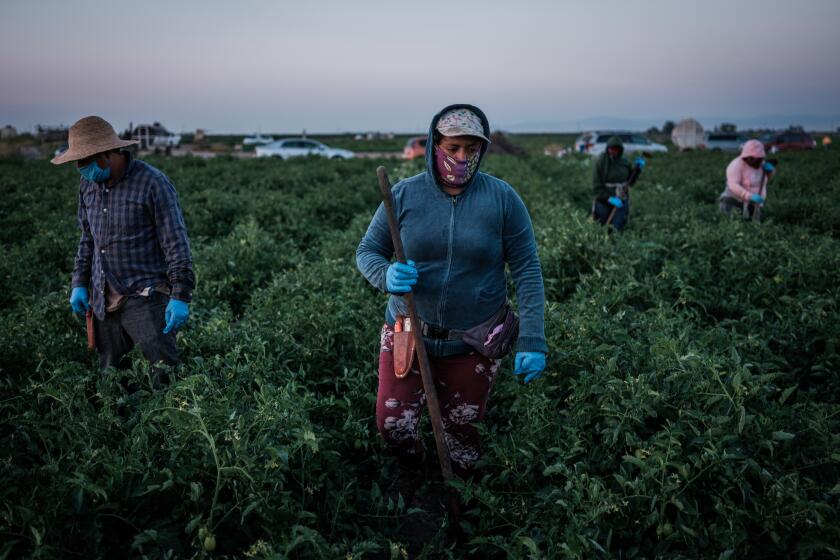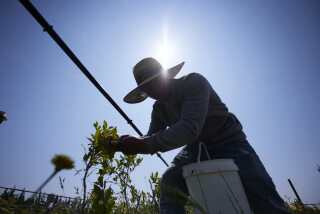COVID-19 strikes Washington state farmworkers and swamps rural hospitals
- Share via
SEATTLE — Earl Edwards left his farm in Jamaica in June, planning to spend a final season harvesting fruit in Washington state.
The 63-year-old father of four had made the journey each summer for more than a decade, counting on the income to supplement his meager earnings raising ginger and sweet potato at home. He was one of about 250,000 temporary farmworkers allowed into the United States on H-2A visas this year.
Edwards telephoned his wife, Marcia, on Friday from COVID-19 quarantine housing at Gebbers Farms, where he had stayed for more than a week while suffering flu-like symptoms. He said he’d been struggling, but his cough was almost gone.
Later that day, she got another call. She was told her husband had collapsed, while taking a shower, and died.
“He was my heartbeat,” Marcia Edwards said Tuesday during a phone interview. “We had been married 18 years.”
The death was the second in a month among quarantined guest workers at Gebbers, one of Washington’s largest apple and cherry growers, where more than 3,000 of the company’s 4,500 seasonal workers come from abroad on the visa program. The fatalities, and positive COVID-19 test results for more than 100 other temporary employees, have renewed fears concerning farmworkers’ exposure to the coronavirus.
Union representatives in Washington had warned last spring that workers crammed into farm housing and toiling close to one another in orchards and crowded fruit-packing plants would be vulnerable to the coronavirus. They tried to get state officials to ban the use of bunk beds in housing that growers provide for as many as 30,000 foreign laborers who work in Washington each summer, arguing that the virus could easily spread between top and bottom levels.
But growers argued that a proposal made to state health and labor agencies to ban the use of top beds would leave half their workers without housing and hurt Washington’s $4.5-billion fruit industry, leading to shortages and price hikes in grocery stores.
In a compromise brokered by Democratic Gov. Jay Inslee’s office, the state agencies permitted bunk beds as long as any unrelated workers sleeping in them were split into household-like groups of no more than 15 people.
Up to 70% of new cases of coronavirus in California’s fertile San Joaquin Valley may be Latino workers, but advocates say they lack testing and access to care.
Under the rules, workers in the small groups would stay together while living, working and moving around in vehicles. Occupants of top and bottom bunks were required to sleep head-to-toe to create maximum distance between workers exhaling and inhaling.
The state’s Department of Labor and Industries began investigating Gebbers last month after learning that one of its H-2A workers from Mexico had died. Juan Carlos Santiago Rincon, who was in his 30s, died July 8 after experiencing symptoms consistent with COVID-19 and being quarantined in farm housing.
Tim Church, an agency spokesman, said Gebbers was found to be out of compliance with the rules instituted due to the coronavirus.
“We had indications that they were using bunk beds but were not following the emergency temporary housing requirements,” like properly separating workers into groups, he said.
Gebbers was separating workers, but into larger groups of 42 on the advice of an infectious disease specialist, said Amy Philpott, a company spokeswoman. The grower had applied to the Labor and Industries agency for a variance to allow the bigger groups, and hadn’t heard back, she said.
Philpott said she didn’t know whether the two men who died were among workers who slept in bunk beds. Both workers were tested for the virus, she said, but their causes of death are as yet unknown.
Philpott also didn’t know whether the two men worked picking or packing fruit.
Marcia Edwards said her husband told her he worked this year for the first time in a cherry-packing plant, instead of in orchards. Outbreaks of COVID-10 have been common in meat plants, where workers are often crowded together, in Washington and other states.
Dan Fazio, executive director of Wafla, an organization that helps farms hire foreign laborers, said that H-2A workers at Gebbers were routinely lodged in bunk beds. He said the regulations developed by officials to separate workers had created numerous complications.
“I don’t think [state officials] have a well-thought-out plan,” Fazio said. For example, workers who normally wake before dawn to avoid summer heat have to get up even earlier, starting at 2:30 a.m., to take 10-minute showers in sequence, he said.
Okanogan County, where Gebbers is located, in north-central Washington, had relatively few COVID-19 cases until recently. The largely rural county with a population of fewer than 44,000 had escaped the fate of urban areas of the state where the U.S. coronavirus epidemic first appeared.
But the county now has the highest rate of cases per capita in Washington, at 892 positive test results per 100,000 residents, according to the latest report by the state Department of Health.
The surge in cases since mid-July has overwhelmed two Okanogan County public hospitals, which are having to refer COVID-19 patients to larger medical centers in distant cities.
Three Rivers Hospital in Brewster, Wash., has no intensive care units or ventilators, said Scott Graham, the hospital’s chief executive officer.
“I’ve got tired nurses, and I’ve got tired doctors,” he said. “We’re taxed to the limit right now with the amount of care that’s needed.”
Helicopters land frequently to transport COVID-19 patients to bigger hospitals, Graham said. He said that Three Rivers and North Valley Hospital, which he also heads, in nearby Tonasket, have enough coronavirus test kits, but results often take 10 days or more, hampering efforts by contact tracers to map and prevent the spread of the disease.
What’s more, mask wearing and social distancing are still not common in the county, Graham said.
“I wish I could look around and see everybody wearing masks and taking precautions,” he said. “It’s very concerning because it means that we’re going to continue to see more cases, which is a big strain not only for our hospitals but for our economy and community.”
More to Read
Sign up for Essential California
The most important California stories and recommendations in your inbox every morning.
You may occasionally receive promotional content from the Los Angeles Times.












